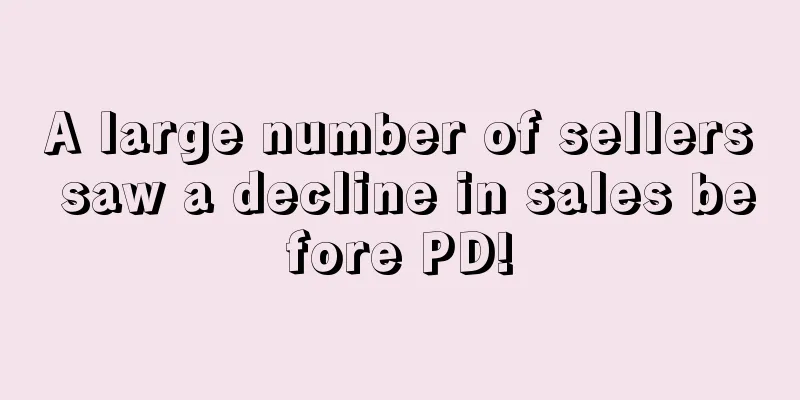"Fight" at your door! Sellers use a "new trick" to crack down on copycat sales

|
Amazon follow-selling refers to multiple sellers on the Amazon platform sharing a product detail page to sell the same product. The basic principle of follow-selling is that if a product already has a detailed product page created by a seller, other sellers who find that they have the same product can follow-sell under this page.
Amazon allows follow-selling, and its original intention of establishing the follow-selling mechanism is to provide buyers with a better shopping experience, that is, to provide buyers with more purchasing options and ensure that buyers can quickly find the products they need. At the same time, it promotes competition and optimizes prices.
However, for those who are followed by others, it means that their rights and interests are violated and the fruits of their labor are stolen. Therefore, many sellers in the cross-border circle hate following others and try every means to take measures to resist following others in order to safeguard their legitimate interests.
Asking the "Industrial and Commercial Bureau" to come to your house, is this the way to deal with copycat sales?
In order to crack down on follow-selling, sellers have tried every possible method, including warning letters, reporting complaints, etc. Some sellers have even gone to the homes of the follow-sellers out of their patience and confronted them face to face, trying to stop the follow-selling behavior and safeguard their legitimate rights and interests through such drastic measures.
However, this kind of behavior of going directly to the door may lead to escalation of conflicts between the two parties, and may even develop into physical conflicts, causing personal injuries. Secondly, this behavior itself may be suspected of being illegal, such as disrupting the living order of others, threatening the safety of others, etc.
So is there a way to deter hijackers from selling on the site without putting yourself in a passive and disadvantageous situation? Not long ago, a senior seller in the industry shared such an incident: after locating the location of the hijacker, a seller directly called the local Industry and Commerce Bureau and asked the Bureau to come to the site to handle the matter.
Fighting against copycat sellers has always been a headache for Amazon sellers. Especially since copycat sellers often like to operate at night when sellers pay less attention, it is simply hard to guard against and difficult to deal with.
"Staying up late every day to grab a shopping cart is not a good idea!" A seller who was still trying to follow the seller at 3 a.m. complained: "I stayed up like this, but the seller who followed me didn't leave, and I left first."
It has been observed that the phenomenon of follow-selling has become increasingly serious in recent years, and it has become more and more difficult to deal with, causing great trouble to many regular sellers. A seller said helplessly a few days ago that he had run a store for many years, and rarely encountered follow-selling in the past few years, and he could drive the other party away with a warning. However, this year, not only have many chains been followed one after another, but the probability of successfully driving them away is not that high.
The reason for this is that competition is intensifying. As the number of sellers on the Amazon platform continues to increase, market competition is becoming increasingly fierce. In order to gain an advantage in the competition, some sellers choose to copy sell.
At the same time, the emergence of follow-selling training has made the already serious follow-selling problem even worse. In order to make personal profits, some unscrupulous service providers have carried out follow-selling training, attracting and teaching potential follow-selling people through various forms, resulting in the increasingly common phenomenon of follow-selling.
According to sellers, some unscrupulous service providers now even provide "teaching" for free, and then make profits by charging commissions.
Generally speaking, products with relatively reasonable prices or a certain profit margin are more likely to be targeted by follow-selling, because they can attract consumers by adjusting prices. However, according to feedback from many sellers, low-priced products are also falling.
Earlier, a seller was surprised to find that someone was copying his product, which was priced at $8.99, and the other party even changed his five-point description. And more than one seller encountered similar situations. According to feedback from many sellers, their products priced at 7.99 or even 5.99 were copied by others, and some were copied by FBA.
Although the phenomenon of follow-selling has become more and more rampant, sellers have not stopped looking for ways to rectify it. For example, the "12315 Report" that has been mentioned repeatedly since the end of last year is an innovative and effective attempt. Many sellers actively use this channel to open up new ideas for combating follow-selling behavior.
12315+12345, the seller's follow-up selling effect is pulled to 100%
Since the beginning of this year, sellers have continuously released the good news that they have successfully driven away follow-selling through "12315". However, although 12315 is useful, it also has certain limitations, including being only effective for follow-selling sellers registered by Chinese companies, relying on the registration information of the follow-selling companies, and being affected by the work of local regulatory authorities.
According to the sellers' practical experience, this method is more effective in big cities, but in some small cities, law enforcement officers may not understand terms such as "follow-selling" in cross-border e-commerce, so they basically will not investigate and punish such behaviors.
Just when everyone was worried, a seller shared a new idea.
The seller said that he tried the now popular "12315" reporting method, but found that the effect was only 50%. Later, by combining it with 12345 (its predecessor was "Mayor's Phone"), the effect was directly increased to 100%. "Sometimes 12315 will shirk responsibility, but calling 12345 again will double the effect."
In addition to him, another seller also discovered the wonderful use of 12345.
Recently, a seller said that 60% of their follow-selling was successfully removed by contacting the Market Supervision Administration. He said that they first reported it to 12315, and if it was not accepted, they would call the mayor's hotline corresponding to the follow-selling address, "It works every time. As long as the Market Supervision Administration can contact them, they will remove the products. If they can't contact them, the follow-selling business license will be pulled as an exception."
However, one method cannot prevent all follow-selling. Sellers need to combine multiple methods to protect their products in all aspects. The following are some effective methods to prevent follow-selling compiled by En.com:
Brand registration: This is an important basis for preventing hijacking. Amazon will be more inclined to protect the product pages of registered brands, and hijackers will face higher risks when hijacking the products of registered brands.
Apply for patents and trademarks: Owning patents and unique trademarks for products can provide sellers with legal protection.
Test Buy: Arrange to buy the products of the follower and collect evidence to prove that their products are different from the seller's or have quality problems. Then submit a complaint to Amazon and ask the platform to deal with the follower behavior.
Send a warning letter: When a follower is found, send a warning letter to him, clearly stating that follow-selling is an infringement and asking him to stop following. However, the effect of this method may vary depending on the attitude of the follower.
Participate in Amazon’s anti-copycat programs: such as Amazon’s “Project Zero” and “Project Transparency”.
Monitor product pages: Check your product pages regularly to identify hijackers. Use third-party tools or tools provided by Amazon to help monitor so that you can take action as soon as hijackers appear.
Optimize products and services: Provide high-quality products and excellent customer service to accumulate good reviews and loyal customers. This can improve the competitiveness of sellers' products and make it difficult for copycats to snatch customers by means such as low prices.
Once a seller encounters follow-selling, he or she will definitely try every possible way to get rid of it. However, Yien.com needs to remind you that it must be done in a reasonable and compliant manner. At the same time, there is a method that should be treated with caution, namely "service providers driving away follow-selling", because you don’t know what means the service provider used to drive away the follow-selling, whether it has violated the platform rules, and some bad service providers even follow-sell themselves, earning service fees and digging into sellers’ traffic and links through follow-selling. Amazon copycat |
<<: A Zhejiang couple is going global and is planning an IPO
Recommend
What is Chief E-commerce Butler & Chief E-commerce Butler Review
Chief E-Commerce Butler is a one-stop full-proces...
What is Shandong Port Group Co., Ltd.? Shandong Port Group Co., Ltd. Review, Features
Shandong Port Group Co., Ltd. is an important prov...
What is Jingtan? Jingtan Review, Features
Jingtan is an Amazon competitor tracking plug-in t...
Using AZ claims, Amazon employees teamed up with buyers to defraud sellers!
Recently, the editor learned from the official Am...
What is oscart? oscart Review, Features
Oscart is a membership-based boutique shopping pla...
Explosion! 200 million units sold in one year, gadgets sweep the market
How many things can you do with a small garbage b...
What is TiansuDa? TiansuDaReview, Features
Tiansuda (Shenzhen Tiansuda International Freight ...
What is enskateboard? enskateboard Review, Features
enskateboard perfectly integrates the long-standin...
Several lawyers sued Amazon for defamation
Since the end of March, many Amazon sellers have ...
Shopee to launch short video app to rival TikTok
On September 11, it was reported that Shopee will...
What's behind the congestion at U.S. ports?
In 2021, container volume at the Port of Los Ange...
What is Jiamei International? Jiamei International Review, Features
Jiamei International (Shandong Jiamei Internation...
77% of Lazada sellers expect sales to grow in the second quarter
Recently, Lazada released the Digital Business Co...
What is Amachete
Amachete is a handy Chrome extension that provides...
What is Mercuryo? Mercuryo Review, Features
Mercuryo is an international company creating a n...









